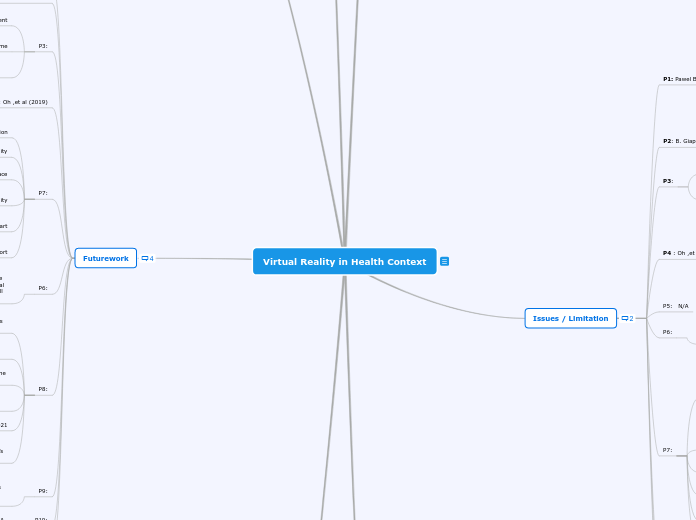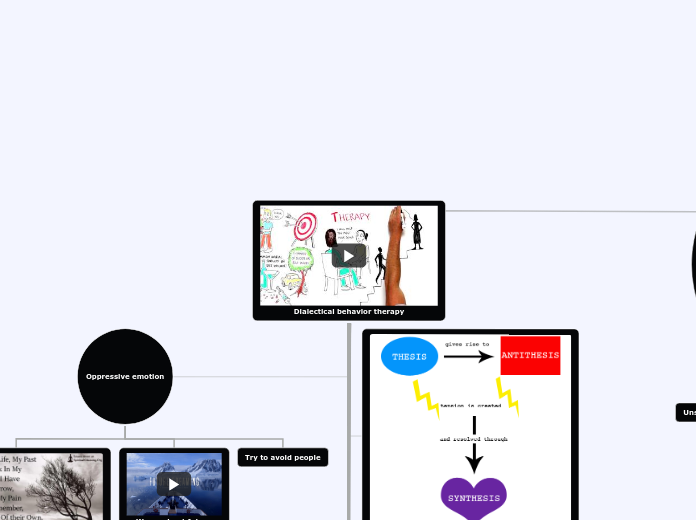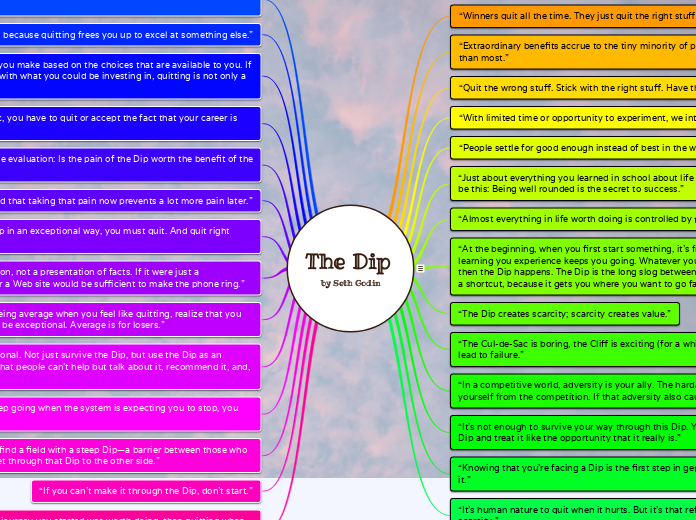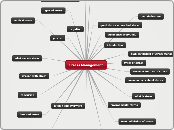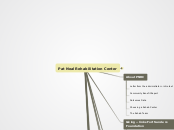Virtual Reality in Health Context
NOTE
P1: Low Cost Devices Used in Virtual Reality Exposure Therapy
P2: Virtual Reality Therapy Can Improve Fatigue and Cognitive Function After Radiation and Chemotherapy
P3:ReHabgame: a non-immersive virtual reality rehabilitation system with applications in neuroscience
P4: Efficacy of Virtual Reality Combined With Real Instrument Training for Patients With Stroke: A Randomized Controlled Trial
P5: Is virtual reality exercise effective in reducing falls among older adults with a history of falls
P6: Significant applications of virtual reality for covid-19 pandemic
P7: Virtual reality art-making for stroke rehabilitation: Field study and technology probe
P8: Developing an automated VR cognitive treatment for psychosis: gameChange VR therapy
P9: An Approach to physical rehabilitation using state-of-art virtual reality and motion tracking technologies
P10: Virtual reality for pain management in patients with heart failure
Benefit / advantages
An important advantage of virtual realityits that it can be used t0 enhance the development of proprioception
(Proprioception-perception or awareness of the position and movement of the body)
Results from the usability testing showed that participants found gameChange easy to use
Several participants commented positively on the immersive nature
Increased upper limb activity
8 participants enjoyed the experience
Decrease of harm & mistakes and more successful surgeries
Valuable approach for standard and unified education
Improving the teamwork in the medical team
Better learning of anatomical positions
movements learned in a VR environment are transferable to real-world similar motor tasks.
Their findings showed that the first process (combined VR and traditional treatment) was more efficient than the other.
The study proves that a combination of VR gameplay and mild exercise in VRT system, improves quality of life (QoL) of cancer patients.
This option might be cheaper in the long run, when compared to expensive medication or psychotherapy sessions, if integrated into their lifestyle gradually.
The study procedure is conducted in the patients' own home (real life setting), increasing its ecological validity.
The VRT system is very considerate towards the patient. It pauses and display warning signs if patients is over-exerted.
This decreases the risk of having ethical issues, as it protects the patients from harm's way.
Allows acrophobic patients to get wider access to this therapy (VR Exposure Therapy)
Confirms the usability of Low-Cost VR device to treat Acrophobia.
Futurework
is this kira solutions kah? :o
for my paper mcm solutions
kinda confused, is it future enhancement of the current study?
yea smth lke that
For future work, full rehabiliation (abduction, adduction, flexion, extension, internal rotation and external rotation) as well as supporting rehavilitation of other muscles and joints (from both the upper and lower trunk)
A process evaluation is being conducted to identify the facilitators and barriers to delivering gameChange in the UK’s National Health Service
The clinical trial will be completed in January 2021
Secondary outcomes include activity levels measured by actigraphy and psychiatric symptoms
The primary outcome measure is avoidance and anxiety in the real world
Patients are randomised either to the VR therapy plus usual care or to usual care only
Aim is to recruit 432 patients with psychosis who are anxious going into everday situations
Further virtual reality application should be targeted over the formation of specifically planned rooms providing with several bigger screen fronts additional to the presently existing small camera screen front in the virutal reality headsets.
Comfort
Augmented reality has the additional benefit of a lighter headset similar to glasses
Meaningful art
Animated graphic that captures the making from the perspective of participant
Accessibility
Customization function could help enable color selection with a single controller
VR space
Teleport functionality should be redesigned to be simpler and more intuitive for low-mobility users
Unfolding materiality
Allow colors to 'age'
Social interaction
Could be possible to share VR displays to peer's devices
prefer to have a larger scale of participants
to clarify the limitation and to confirm the findings regarding the efficacy of VR combined with real instrument training on the neurorehabilitation of patients with stroke.
That increases the motivation by gathering more patients to cooperatively (or competitively) interact and play the game
to incorporate the possibility of implementing social
interactionsthrough online gameplay at patient’s home
experiments involving individuals with motor impairment
Treat various phobias, using various low-cost VR gear
Conclusion?
P6
This concept has been broadly employed in the domain of the health sector and effectively
proposed in various diseases.
This approach also provides an extensive edge to defend and confront the present epidemic COVID-19
by enhancing the skill, confidence, performance and overall attitude of healthcare persons
four experts tried and evaluated the game, concluding that its show promising results for the sake of shoulder rehabilitation, pointing out that an expert should supervise at least the first session.
VR art-making has some potential as a rehabilitation medium because it enables artists to use the space around their bodies as a canvas through physical gesture.
VR art-making has some promise but needs significant improvements to support social interaction, situated decision-making, reflection, physical engagement with digital materials and meaning-making before it will be appropriate for artists with stroke-related impairments.
Wii Fit balance training was more effective than conventional balance training in reducing falls risk and incidence among these institutionalized older persons with a history of falls.
real instrument in a VR environment is an innovation transactional intervention options for the comprehensive rehabilitation of patients in the chronic phase of stroke.
it is more effective at promoting the recovery of the fine motor function compared to conventional therapy.
it has improved the functional ability of the upper extremites in the chronic phase of stroke.
Some positive elements of the ReHabgame that was claimed by the player were the beautiful scenery and appealing feedbacks they received which had a direct relation to the
engagement of a player.
aimed to distract the player’s attention towards the
exciting aspects of the game to avoid fatigue
The therapy provided an adequate physical and mental engagement that offered sufficient visual feedback throughout treatment sessions.
Since VRT is non-invasiveness and entertaining, it improves motivation and compliance.
The combination of VR gameplay and mild exercise in the VRT system can improve Quality of Life by reducing pain and depression while improving fatigue and cognitive function.
As predicted earlier, using large area tracking system allows better immersion.
The conducted studies has proven that the low-cost, newly developed VR devices can be successfully used for building immersive Virtual Reality applications for exposure therapy
of certain phobias.
Definition of VR
P8:Baldominos et al., 2015
The term "Virtual Reality" is referred explicitly to immersive 3D virtual reality such as that attained using 3D glasses
P8: Lambe et al., 2020
VR is described as a three-dimensional computer simulations of environments that can be navigated around and interacted with.
Virtual environments can elicit similar cognitive and emotional responses to their real world counterparts.
P7: Alex et al., 2021
Virtual reality provides a sense of presence fostered by a head-mounted display that situates the user in an immersive environment.
VR has been lauded as a promising form of rehabilitation because of its ability to provide rich visual experiences and transferable skills, control over dynamic environments and measurements of responses, and the ability to present greater risks than would be possible in real life.
P6: Singh, et al (2020)
Virtual reality (VR) is defined as developing simulated expertise which is somewhat similar to the real-time situation.
Virtual reality is a computer hardware and software systems that generate simulations of imagined environments via visual, auditory, and tactile feedback
P3 : Esfahlani ,et al (2017)
VR as a computer-based, interactive, multi-sensory
environment that occurs in real-time.
It provides enhanced feedback about movement
characteristics, and advanced motor task learning and execution
virtual reality (VR) rehabilitation techniques could create an environment that recovers health conditions as well as community integration
(None stated)
Software and Hardware
P10:
Forest of Senerity (Holosphere VR, Birmingham,UK) application
Oculus GO VR
Developed using Unity3D
Soccer game and the patient takes the role of the goalkeeper
Intel RealSense (Motion-Tracking device)
Oculus Rift DK2 (VR Glasses)
gameChange can be delivered using commercially available VR equipment
Development was carried out by Oxford VR
a spin-out company from the University of Oxford
gameChange is an automated psychological therapy
HTC Vive controller
designed for use for the left and right hand
Oculus Rift controller
designed for a specific left and right hand
Google's Tilt Brush
works with two different controllers
an open-ended painting tool
used as the technology probe
Nintendo Wii Fit Balance Board
3-dimensional manipulator
various instruments with 3 degrees of freedom
Conventional computer
Monitor
Joystim for the VR combined with real instrument training
Random object (ROG) generator
The Monte-Carlo Tree Search (MCTS)
Thalmic™ Labs Myo
upper-arm function; hand movements; and advanced hand activities data
Microsoft Kinect™
The postural balance (increments of displacement of the person’s centre of mass and upper body joints)
2-D Game Luminosity
VRT Software
Portable peddler
To be used along with Body Motion Sensor (BMS), to simulate cycling motion in VRT system
Biometric Sensor for Heart Rate (HR) and Oxygen Saturation (O2Sat)
To check if participants are over-exerted when playing the game in VRT System
Body Motion Sensor (BMS)
To be used along with 'Portable peddler' to simulate cycling motion in VRT System.
VR Headset (Model not specified)
To be used in VRT System
Software
Unreal Engine
3D engine for Oculus Rift V1
EON Studio
3D engine for nVisor MH 60
3D Studio Max
Create VR application
Hardware
Windows Compatible Joystick
To be used with VR devices, for movement in VR environment.
OMRON M2 HEM-7121-E
Measure Pulse Rate (bpm: beats per minute) and blood pressure (measurements of blood pressure not stated in the study). Additional pulse rate measurement, to confirm validity.
Beurer PM200+ meter
Measure Pulse Rate (bpm: beats per minute)
Oculus Rift V1
Represents low-cost VR device
nVisor MH 60
Represents expensive VR device
Issues / Limitation
shud..be..
nda pyh include benefits?
P10: N/A
N/A
VR headset made several participants nervous
Result was not as expected
Printed screenshot was relatively meaningless and disconnected from the embodied experience of art-making
Constrained timing
Participants did not have time to develop knowledge and facility with the materials
Lack of social interaction with other participants
Tiring
Mid-air gestures may require more strength hence losing precision with fatigue
Lack of control
Virtual brush strokes created with a controller and trigger yielded less sense of control
Inability to achieve a desired shape
Unable to apply fine pressure with fingers and hands with controller
Some of them are in starting phase. In the future, it will be more challenging and competitive
for VR in terms of effectiveness, precision, economic facts, etc.
P5: N/A
baseline parameters were not set closely between the experimental and control group due to the small sample size of this trial.
did not evaluate the long-term effects of the intervention, only the effects at 1 month after training.opic
Small sample size
ethics approval process
time-consuming therefore the study was limit to the volunteers of communities.
sample of participants
not fully representative of the diverse population of stroke patients
Number of paritcipants not specified.
Decrease in Immersion level for some participants
Participants with sight impairments were not allowed to wear glasses or contact lenses. This makes the their sight blurry through-out the experiment, heavily decreasing their immersion level.
Low ecological validity
This is because, the experiment is conducted in a highly controlled environment. This means that the findings in the study might be ungeneralizable to real-life situations.
Small sample size + Low statistical power
The results on this study might not be generalizable to all people with acrophobia (fear of heights).
Method
P9:
Participants:Four experts working in the field of physiotheraphy tested the product
experts showed interest and expectation in the developed proof of concept, and they agreed on the fact that virtual reality and motion tracking are promising technologies to be applied to physical rehabilitation
One expert stated that the system should have a feature to limit the exercises time, to prevent patients from
performing the movements during too much time, thus reducing the effectiveness of the treatment.
They agree on the fact that at least the first session must be supervised by a physiotherapist to check that
the patient is performing the right movements, and the supervised session mode has proven successful for that
purpose.
They have pointed out that an average assisted kinesiotherapy for a patient with shoulder injury takes
about 20 minutes, and engaging in the soccer game could allow them to complete the exercises on their own
They all think that the animations are fluid
(The game is running at a minimum rate of 30 frames per second).
None of the experts suffered from dizziness, nausea or other sickness while wearing the virtual reality glasses
The movement performed by the patient would correspond to those required by a treatment of active kinesiotherapy and performing shoulder abduction of over 90 degrees would achieve an increase of the shoulder joint mobility, which would in any case depend on the patient and the injury severity.
The sight is block when the patient wear the virtual reality, so he is unable to see himself moving his upper trunk joints (ie the shoulder, elbow & hand)
The rehabilitation session can be either supervised or
autonomous
The game developed in this work focuses on abduction & adduction
Physical rehabilitation is bounded to the rotator cuff on the right shoulder
P8:
Usability testing
Success criterion set at beginning of project was for 90% of users to rate gameChange as immersive, easy to use and engaging.
Success criterion was achieved
Second usability testing (post-completion)
6 patients
Formal usability testing (pre-completion)
5 patients
Patients with lived experience of psychosis completed a session of gameChange VR therapy, providing feedback and completing the usability questionnaire.
Usability questionnaire was developed during the project
gameChange
VR Therapy
In each scenario, patients have to carry out key tasks
Each session lasts approximately 30 minutes
Begins in the coach’s room where the patient meets Nic, their virtual coach
Scenarios
Specifically designed to activate fearful cognitions and thus provide opportunities for the patient to test out their fears
The list of six gameChange scenarios was generated by the Lived Experience Advisory Panel(LEAP), and includes:
•a bus;
•a street;
•a cafe;
•a pub;
•a doctor's waiting room;
•a shop.
P7:
Participants: 14 stroke survivors with disabilites
Two-part study
Experiential VR interviews using 3D tool as technology probe
Asked participants to describe the experience, perceptions of VR art compared to traditional art
Each participant had a single session of 35 minutes
One-on-one experiential interviews in person while participant used VR
Field study of traditional art-making
Weekly site visits that lasted for 2 hrs and 30 mins
P6:
A brief study on Virtual Reality and its applications for the COVID-19 pandemic is carried out by
employing keywords as Virtual reality or VR and COVID-19 from the databases of SCOPUS, Google
Scholar, PubMed, Web of science Academia and ResearchGate.
P5:
Participants: 60 older subjects aged 65 & above living in a nursing home.
RESULTS
Two-way repeated measures of ANOVA did show significant interactions in the PPA scores and falls incidence.
Independent test showed that there were no statistically significant difference in the average pre-test PPA values and numbers of falls over previous one year between two groups.
Conventional exercise
Using VR Wii Fit
Exercise organized in 1 hour session held on 3 days a week for 6 weeks.
P4 : Oh ,et al (2019)
Participants: 31 patients in the chronic phase of stroke who had previously undergone inpatient poststroke rehabilitation
Measurements were evaluate and analuzed using certain guidelines
Manual Muscle Test (MMT)
hand grip test
Box and Block Test
9-Hole Peg Test (9-HPT)
modified Ashworth scale (MAS)
the Korean-Montreal Cognitive Assessment (K-MoCA)
RESULT?
The experimental group showed significant improvements in the Box and Block Test
both control and experimental groups showed significant improvements in the MMT for finger extension
experimental group exhibited significant improvements in the MMT and MAS for wrist extension
Patients were randomly divided into a group by a computer program
Controlled
seated at a table and were subjected to a standardized treatment program
Experimental
underwent real instrument training in a VR environment and were supervised by an occupational therapist.
P3:
Participants : 20 post stroke individuals
a Motor Assessment Scale (MAS) is the standardised assessment tool for this study
RESULT ?
The finding showed that the therapy provides an adequate physical and mental engagement through sufficient visual feedback throughout the sessions.
the participants commented very positively and reported that
the activities covered a good ROM for the upper body
The majority of participants enjoyed the rehabilitation sessions and the ReHabgame
activities
it is further assesed using an engagement questionnaire that was developed to assesed ReHabGame.
3 concepts that will be evaluated in the questionnaire
Absorption , the total engagement in the present experience
Presence , the sense of being within the game
Flow , the enjoyment of the game
Players interact with the virtual objects in the virtual park through three scenarios (case studies)
1. Reach-Graps-Release fruit game
2. Reach-press-hold buttons game
3. Reach-Press button game
P2: B. Giap et al (2019)
Participants: post cancer patients with self-reported moderate to severe 'chemo brain' symptoms
(number of participants was not specified in this study)
Result
Evaluation
Followed by evaluations in 2 week intervals, for a total of 5 evaluations
First evaluation were scored pre-treatment
Measurement of Dependent Variables
Secondary Dependent Variables
4) Observation of pain medication used by participants
3) Subjective Report
To assess pain
2) Mini Mental Status Exam (MMSE)
To assess Cognitive Dysfunction
1) standardized Patient Health Questionnaire (PHQ-9)
To measure participant's depression level
Primary Dependent Variables
1) PIPER fatigue score
To measure participants subjective fatigue level
If participants over-exerted (e.g Heart Rate too high or Oxygen Saturation too low), system will pause and display warning.
Each participants were provided with the necessary equipments for both VRT system and 2-D Luminosity.
First 2 weeks: Participants was randomized to play VRT system or 2-D Luminosity, at their own home. 15-30 minutes session per day, 5 days a week.
Second 2 weeks: Rest. No game activity.
Last 2 weeks: Play 2-D Luminosity
P1: Pawel Bun et al (2016)
Participants: 20 Individuals, inclusive of people with and without fear of heights, and people with and without sight impairments.
Gender: 17 male, 3 female
Age range: 23 to 32 years old
Results
5. For Group 1, 2 and 4, The difference in mean pulse rate value was approximately 8 bpm. While the maximal recorded value was 10bpm higher.
For Group 3, the diffference in mean pulse rate value was 13.2 bpm, and the maximal value was 17.2 bpm.
The difference in measured values were significantly higher in Group 3, when compared to the other groups.
4. Maximal pulse rate was recorded during platform(elevator) ride, in Group 3. (113.2 bpm and 113.8 bpm)
3. Group 3 has the highest overall pulse rate.
2. Group 3 participants' body movement was less stable than other groups, and they also reported typical acrophobia (fear of heights) reactions, such as vertigo and leg tremor.
1. Group 3 participants took more time to complete the tasks.
Measurement for fear of height symptom during experiment:
1) Pulse Rate with 2 Pulsometers
2) Manual pulse checking on neck artery for 30 seconds
3) Self-report from participants
4) Observation of participants reaction
The above tasks were done twice:
- first one using nVisor MH60 (expensive VR device)
- second one using Oculus Rift CV1 (low-cost device)
After preparation and initial pulse measurement, each user was transported to the roof of the building (in VR) and perform the following actions:
1) Enter one of the moving platforms
2) Go one level down
3) Leave the platform and enter a bridge between buildings
4) Go to another platform
5) Enter the platform
6) Go down to the ground level
7) Repeat the sequence in inverted order (get back to the roof using the same route)
Participants are divided into 4 main groups, according to their individual features:
Group 1: With no sight impairment and no fear of heights
Group 2: with both sight impairment and fear of heights
Group 3: with no sight impairment but with fear of heights
Group 4: with sight impairment, but no fear of heights
